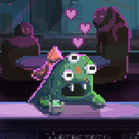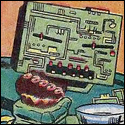|
Cockmaster posted:What are you talking about? It's still there: weird, not here. Ah well. http://store.makerbot.com/filament I was considering buying the original replicator, but 2k is a bit steep for me personally. I'm interested in principle in the idea of the dual extruder support structure with PVA. I think something like this is cool http://richrap.blogspot.com/2012/08/3-way-quick-fit-extruder-and-colour.html, its too bad the current controller electronics isn't really set up for something like it. Assuming you were able to mount something like 5 extruders (for CMYKW) runnng into one printhead, how would you implement that on the controller side? You'd need like 8 motor channels when the systems now might come with 5. A lot of the systems offhand talk about expansion boards, but I don't see that any actually exist now.
|
|
|
|

|
| # ? May 9, 2024 06:29 |
|
Cockmaster posted:I don't know about you, but I find it kind of disturbing how their website is hyping up the advantages of PLA. In context, it sounds very much like they're just trying to make excuses for leaving a $100 bed heater out of a $2200 printer. ABS + kapton tape + heated bed is basically prints losing adhesion madness for anyone not using a Makerbot. Note that the Makerbot still uses rafts which most people that don't have Makerbots stopped using a year or more ago. I believe the current reliable method for ABS+kapton/glass+heated bed is laying down "ABS juice" which is just ABS dissolved in acetone. Makerbot's toolchain is pretty out of date too compared to the more modern stuff. Makes a lot of sense that they stuck with that crap if they are pulling away from open source. PLA doesn't need a heated bed if you have a nice surface for it to stick to like a painter's tape, a sandblasted piece of glass or something exotic like a carbon plate. Obsurveyor fucked around with this message at 02:36 on Sep 21, 2012 |
|
|
|
Obsurveyor posted:ABS + kapton tape + heated bed is basically prints losing adhesion madness for anyone not using a Makerbot. Note that the Makerbot still uses rafts which most people that don't have Makerbots stopped using a year or more ago. I believe the current reliable method for ABS+kapton/glass+heated bed is laying down "ABS juice" which is just ABS dissolved in acetone. Makerbot's toolchain is pretty out of date too compared to the more modern stuff. Makes a lot of sense that they stuck with that crap if they are pulling away from open source. PLA has issues of its own to me. It's fine to print most things with, I use it often in my printers. If I want to make a shot glass out of PLA, I can't. If I want to make a bottle opener out of PLA, I have to make sure I never get it wet with alcohol. PLA is good for most things, but ABS still comes in handy, shunning that fact will ruin MakerBot. The fact that they didn't launch a dual extruder printer also is a turn off to me, because not only did they lose the feature of a heated bed, they also lost the dual extrusion for now, and they are still charging more than the original dual extrusion system. To me it seems like they are trying to enter the actual engineering market, and pull away from the maker movement.
|
|
|
|
UberVexer posted:The fact that they didn't launch a dual extruder printer also is a turn off to me, because not only did they lose the feature of a heated bed, they also lost the dual extrusion for now, and they are still charging more than the original dual extrusion system. They did, it's called the 2X, it's going to have dual extruders and a heated bed/be ABS compatible. (For $2800)
|
|
|
|
UberVexer posted:PLA has issues of its own to me. It's fine to print most things with, I use it often in my printers. If I want to make a shot glass out of PLA, I can't. If I want to make a bottle opener out of PLA, I have to make sure I never get it wet with alcohol. PLA is good for most things, but ABS still comes in handy, shunning that fact will ruin MakerBot. The fact that they didn't launch a dual extruder printer also is a turn off to me, because not only did they lose the feature of a heated bed, they also lost the dual extrusion for now, and they are still charging more than the original dual extrusion system. Isn't PLA not quite as tough as ABS? I was potentially interested in printing out parts for an antweight fighting robot.
|
|
|
|
Yes PLA is a harder material and more brittle. It is less impact resistant than ABS
|
|
|
|
I like ABS but I'd trade the hassles with shrinkage, etc for more reliable and consistently accurate prints. I don't think I'd fret much over moving to a PLA specialized printer for that. I'd have to be prodded to it though as I'm set up for ABS and am not going to switch over just for the heck of experimenting.
|
|
|
|
The 2x is not out yet is really my problem. The technology exists and they just are waiting until January.
|
|
|
|
UberVexer posted:If I want to make a shot glass out of PLA, I can't. If I want to make a bottle opener out of PLA, I have to make sure I never get it wet with alcohol. What's this about? We have some PLA kid's cups that we use as lowballs when the glasses run out and haven't had a problem.
|
|
|
|
Splizwarf posted:What's this about? We have some PLA kid's cups that we use as lowballs when the glasses run out and haven't had a problem. PLA is alcohol sensitive, like ABS is acetone sensitive and PVA is water sensitive. PLA will melt if alcohol is put in it or it is put in alcohol. It's fine for kid's beverages. Much of 3D modeling for starters revolves around making glasses and shot glasses, it would be pretty terrible if you poured a shot and watched your model melt. Edit: The PLA cups you buy at the store are also not "Pure PLA" and they are a mixture of different plastics, the bulk of which is PLA. UberVexer fucked around with this message at 15:25 on Sep 21, 2012 |
|
|
|
UberVexer posted:PLA will melt if alcohol is put in it or it is put in alcohol. Can you cite this? I can't find anything to really confirm this, either way. And this site says that PLA is 'water and alcohol resistant'. Also, if PLA did dissolve in alcohol, I have a feeling this PLA-dissolving solution wouldn't be necessary. And from another site: quote:I tested: thexerox123 fucked around with this message at 15:31 on Sep 21, 2012 |
|
|
|
Solo sells PLA-lined disposable cups.
|
|
|
|
babyeatingpsychopath posted:If PLA dump in a 12oz glass of rubbing alcohol. If ABS, dump in a 12oz glass of acetone and cover with aluminum foil and a rubber band. This works for PLA. Also I use PLA as support for my weird ABS prints and then melt it away. UberVexer fucked around with this message at 15:44 on Sep 21, 2012 |
|
|
|
UberVexer posted:Also I use PLA as support for my weird ABS prints and then melt it away. Using alcohol? Why does every other person that I can find through searching who wants to dissolve/has dissolved PLA supports end up using a much more volatile mixture of chemicals? (As I linked to above.) thexerox123 fucked around with this message at 16:22 on Sep 21, 2012 |
|
|
|
This argument is probably running into the likelihood that PLA comes in a lot of more and less alcohol-resistant forms.
|
|
|
|
Good news! We're going to have Panda Robotics and their upcoming PandaBot at our next Toronto 3D Printers meetup this Monday! If you're in the Toronto area, come visit! The doors open at 7pm and we have some informal talks around 8pm.
|
|
|
|
Remember kids, not all alcohol's are the same: https://www.google.com/url?sa=t&rct...1zc_Yiw&cad=rja Ethanol (drinking alcohol) is extremely unlikely to dissolve any composition of PLA, industrial cleaning alcohols will do it however. I guess whatever sort of rubbing alcohol (normally a methanol blend) UberVexer is using dissolves PLA quite well, I suggest UberVexer write down what the concentrations are so that in the event that wherever UberVexer is buying it from stop stocking it another equivalent mixture can be tracked down. Edit: Oh hey, we can 3d print wood now; through existing printers. https://www.3ders.org/articles/20120920-laywoo-d3-new-fdm-filament-can-print-wood-with-tree-rings.html Linux Assassin fucked around with this message at 17:18 on Sep 21, 2012 |
|
|
|
Alcohols are not all chemically identical? Well poo poo there goes my plan to switch to mixing my drinks with wood alcohol or rubbing alcohol/isopropyl alcohol to save money   Fudd? Didn't they take that off the market after all those hillbillies went blind in the 30's?
|
|
|
|
Linux Assassin posted:Edit: Well holy poo poo. That's awesome. Wonder what kind of dual-head shenanigans you can do with it?
|
|
|
|
Splizwarf posted:Well holy poo poo. That's awesome. Wonder what kind of dual-head shenanigans you can do with it? One of the things I am interested in is that you can darken it by varying the temprature on the extruder. In and of itself that's not that impressive (burn the wood fibers vs don't burn the wood fibers)- but I wonder if some sort of narrow range temperature-reactive PLA/ABS might be possible that gets a relatively full spectrum in the comfortable temperature point for a 3d printer that would then let you print in full colour. It would be really cool to have just one spool of say white PLA that is still white at 180 Celsius, say red at 190, yellow at 200 and blue at 210, black at 220- with the full spectrum in between. (Of course this plays to my want for a 3d printer to actually be a household production device, rather then an at home DIY rapid prototyper)
|
|
|
|
boondocksts posted:Has anyone received a B9 yet? He just sent out 200 of them so I assume they'll be getting them soon!
|
|
|
|
Claes Oldenburger posted:He just sent out 200 of them so I assume they'll be getting them soon! People have been unboxing them the last few days. Should start seeing some pretty cool demos soon.
|
|
|
|
Linux Assassin posted:It would be really cool to have just one spool of say white PLA that is still white at 180 Celsius, say red at 190, yellow at 200 and blue at 210, black at 220- with the full spectrum in between. (Of course this plays to my want for a 3d printer to actually be a household production device, rather then an at home DIY rapid prototyper) This probably isn't possible. You have to map a 1d variable (temperature) to a 3d color space (RGB/CMY).
|
|
|
|
UberVexer posted:The 2x is not out yet is really my problem. The technology exists and they just are waiting until January. I would think that the price tag would be a bigger problem - $2800 is well beyond the means of most hobbyists, and even $2200 is pushing it.
|
|
|
|
Spazzle posted:This probably isn't possible. You have to map a 1d variable (temperature) to a 3d color space (RGB/CMY). I don't agree- wavelength is a 1d variable, and the entire visual spectrum of light is contained within wavelengths of different width. However it does not need to be a 'pure' mapping that covers tens of thousands of colours in 16 bit colour spectrum, achieving even a 4 bit colour spectrum would be awesome. Even just having a few simple colours that could change would radically increase the possible spectrum that could be printed as 'finished product, ready to go' without requiring multiple print heads or some sort of plastruder-mixer device.
|
|
|
|
Linux Assassin posted:I don't agree- wavelength is a 1d variable, and the entire visual spectrum of light is contained within wavelengths of different width. However it does not need to be a 'pure' mapping that covers tens of thousands of colours in 16 bit colour spectrum, achieving even a 4 bit colour spectrum would be awesome. Even just having a few simple colours that could change would radically increase the possible spectrum that could be printed as 'finished product, ready to go' without requiring multiple print heads or some sort of plastruder-mixer device. Wavelength may be a 1d variable, but to describe colors which are mixtures of multiple wavlengths you need more information than a single number. Computers use the RGB spectrum (and print uses the CMY spectrum) because our eyes effectively can percieve three bands of colors, which a given wavelength of light stimulates in different amounts. Those three bands are what we percieve to be RGB. You are suggesting a material which traces a path through color space with only a single driving variable (temperature). The chemistry you suggest is probably absurd, but really, you are just as limited by your resolution. Every other color printing technology is 3+ inks for a reason, why do you think you have some magical insight that allows you to get away with one?
|
|
|
|
Spazzle posted:Wavelength may be a 1d variable, but to describe colors which are mixtures of multiple wavlengths you need more information than a single number. Computers use the RGB spectrum (and print uses the CMY spectrum) because our eyes effectively can percieve three bands of colors, which a given wavelength of light stimulates in different amounts. Those three bands are what we percieve to be RGB. You are suggesting a material which traces a path through color space with only a single driving variable (temperature). The chemistry you suggest is probably absurd, but really, you are just as limited by your resolution. Every other color printing technology is 3+ inks for a reason, why do you think you have some magical insight that allows you to get away with one? Ok first, it seems that I think I am discussing two seperate topics, and you think I'm discussing one topic. The two topics I am discussing: 1. The concept of a filament of PLA that can colour change based on what temperature you expose it to in the extruder, I originally postulated that it might be able to go full spectrum, but upon consideration of your comment, acquiesced that getting even 4 bit colour (16 perceptibly different colours) with it would be 'awesome', given even further consideration, getting even 3 colours (red green and blue, or red yellow and blue, or black, white and grey, or really any three colours) could be game changing for final products. I do not believe I have any magical insight, nor do I envision myself being the one to somehow bring this to market, I was simply postulating that I see it as possible and that it would be really great to have. 2. The concept that it is not possible to map the full spectrum of visible light on a single variable, which I do not agree with at all. Possible != probable. Colour (as we see it) is a single wavelength, though very few things in nature are a 'single' colour, and we combine things with multiple colours effectively because our eyes naturally blur and join things- when you see a purple paint as a mix of red and blue paint, it's not actually combined, it's a suspension, get a powerful enough microscope and you will be able to see individual red and blue flecks making up the colour that we see. True purple does exist however and can at least be artificially generated directly as light. As such it is technically possible to produce all colours in human vision via a single variable change. It is also technically possible to do lots of things that are unlikely/impossible to do in the real world for myriad of reasons. So to recap: I agree I was overly ambitious to envision full spectrum based on heat of extruder. I do think it might be possible (if expensive) to produce a filament that can produce a small spectrum of colours based on extruder temperature, and that that would be really great for finished products in a 3d printer. I do not however agree that the full spectrum of colour cannot be reproduced using a single variable (this of course ignores the full spectrum of colour intensity; just the spectrum of colour itself). I hope that that clears any confusion we may be having in our conversation, if you still disagree with those two statements I am more then happy to continue the discussion.
|
|
|
|
Spazzle posted:Wavelength may be a 1d variable, but to describe colors which are mixtures of multiple wavlengths you need more information than a single number. Computers use the RGB spectrum (and print uses the CMY spectrum) because our eyes effectively can percieve three bands of colors, which a given wavelength of light stimulates in different amounts. Those three bands are what we percieve to be RGB. You are suggesting a material which traces a path through color space with only a single driving variable (temperature). The chemistry you suggest is probably absurd, but really, you are just as limited by your resolution. Every other color printing technology is 3+ inks for a reason, why do you think you have some magical insight that allows you to get away with one? your monitor only has red, green and blue phosphors.
|
|
|
|
Linux Assassin posted:Ok first, it seems that I think I am discussing two seperate topics, and you think I'm discussing one topic. rotor posted:your monitor only has red, green and blue phosphors.
|
|
|
|
Plus, you'd need to be able to mix the PLA while hot then extrude it, to actually get different colors. Most thermochromatic inks just go Blue -> Black or Green -> Yellow or similar. I would expect any sort of thermochromatic plastics would have a similar binary effect.
|
|
|
|
rotor posted:your monitor only has red, green and blue phosphors. Also blue, yellow and/or white nowadays depending on the model. 
|
|
|
|
Trabisnikof posted:Plus, you'd need to be able to mix the PLA while hot then extrude it, to actually get different colors. the point of the monitor analogy is that if you can emit small enough dots you really only need 3 (or 4, or 5) colors
|
|
|
|
rotor posted:the point of the monitor analogy is that if you can emit small enough dots you really only need 3 (or 4, or 5) colors Too bad plastic filament, you know, doesn't work even remotely similar to monitors. Wouldn't it be coloured by pigment, whereas monitors actually emit light? There is a huge difference between these processes and how they work. See here, for instance: quote:When it comes to color behavior, light behaves in opposing ways to pigments. The primary colors of light are the secondary colors of pigments. Mixing a given color pair together will bring different results in light and pigment. Adding more colors to the mix will sully or darken the color in paint, but will appear paler and brighter in light. The only thing they have in common is their complementary colors. But mixing complementary colors together will result in black in pigment; but white for light. The methods for getting colour changes to work in something that is, (state-of-matter-wise) unchanging, behind glass, and emitting light is pretty different from the chemistry/material science needed to get a plastic to change colours depending on temperature. Especially if you want it to then stay that colour and not fade over time, somehow. Maybe once science really gets a grasp on nanomaterials, it would seem a bit more feasible. thexerox123 fucked around with this message at 00:41 on Sep 23, 2012 |
|
|
|
Either printing color-correct pieces and assembling them or painting smaller areas the target color will yield superior results in nearly any case for the foreseeable future anyway.
|
|
|
|
thexerox123 posted:Too bad plastic filament, you know, doesn't work even remotely similar to monitors. Wouldn't it be coloured by pigment, whereas monitors actually emit light? There is a huge difference between these processes and how they work. See here, for instance: ever seen a halftoned color photo?
|
|
|
|
If my printer has two Z-axis motors (Hadron), should I get a RAMPS board with two Z-axis connectors, or just wire up both motors to a single connection? http://ultimachine.com/ramps-pre-assembled-kit-complete I've also seen cheaper printer motherboards, but it seems like it might be better to go with something more modular like the RAMPS.
|
|
|
|
Locus posted:If my printer has two Z-axis motors (Hadron), should I get a RAMPS board with two Z-axis connectors, or just wire up both motors to a single connection? They do the exact same thing. You're just paying to have them solder a connector on the RAMPS board for you.
|
|
|
|
I made a thing! It's a rail-mounted foregrip for my Steyr AUG, printed in polycarbonate.  Polycarbonate is seriously hard to work with, it requires very high temperatures (close the the temperatures where Teflon starts emitting toxic fumes), leaves tough little strings all over, dribbles like gently caress, does not want to stick well to most bed surfaces and worst of all, it warps and cracks real bad. I think I've solved the worst of the issues well enough for me to start using PC for actual applications. Basically I smear a layer of ABS glue (ABS scraps dissolved in acetone) on a hot glass printbed (90+ C). This way the acetone is boiled off fast which leaves a layer of ABS plastic that is very well stuck to the glass. The hot polycarbonate then fuses wery well to this ABS layer, ensuring good adhesion. When slicing, disable cooling fans and modules, you want the polycarbonate to stay warm to minimize the warping. To avoid the cracking issue I was having with taller PC prints I've been designing what I print to not have weak spots in the middle layers, since that's where I've been seeing cracks. After printing I lay the print down on the hot printbed for a while, then turn that off too. I have no idea if this is necessary or even helpful, but I think it helps to let the print cool evenly across z-layers.  And mounted! 
|
|
|
|
Wow, slick in that it actually mounts to the rail and looks actually properly designed Is the only contact point the rail? Neato. Curved surfaces are black magic to me 
|
|
|
|

|
| # ? May 9, 2024 06:29 |
|
Mister Sinewave posted:Wow, slick in that it actually mounts to the rail and looks actually properly designed I ordered all the parts for MendelMax over the weekend. There is some local 3D printing guru nearby who showed me his and it looked pretty nice as a starting point. Wondering if I should get a shapeoko CNC mill as well.
|
|
|

























